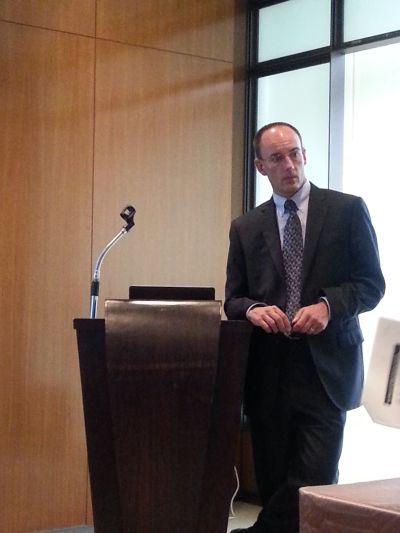Despite of downpours and strong gusts caused by severe tropical storm Trami that hit Taiwan on Aug. 21, 2013, optical inspection giant KLA-Tencor Corporation outlined its 2013 product plans and business strategy at a press conference in Taipei that day. The company was positive about the wafer OEM and memory inspection equipment market. KLA-Tencor that usually keeps a low profile responded to questions concerning competitor Hermes Microvision Inc. (HMI), a large Taiwanese E-beam inspection equipment manufacturer. KLA-Tencor emphasized, while E-beams have higher resolution than optics, its inspection speed is too slow, and pointed out optical inspection is still the mainstream inspection method on the market. The company also announced it will be establishing equipment training centers in Taiwan, which reflects the aim of KLA-Tencor’s trip to the country to firmly establish its presence.
 |
|
KLA-Tencor CMO Brian Trafas speaking at a press conference held on Aug. 21, 2013 in Taipei. (LEDinside Photo) |
KLA-Tencor v.s. HMI
KLA-Tencor maintains a leading position in optical inspection, but HMI’s E-beam inspection equipment potential should not be underestimated. The large Taiwanese equipment manufacturer’s E-beam inspection market share is growing, with inspection resolution reaching 3 nanometers. These have led to KLA-Tencor’s CMO Brian Trafas to clarify market claims of optical inspection being replaced by E-beam inspection at the press conference. In a presentation at the conference Trafas pointed out, to find a 10 nm defection in a 30.42 centimeters (12 inch) wafer is equivalent to locating a NT$ 1 coin in an area as big as Taiwan. Using optical inspection equipment, it would only take one hour to find the defection, but it would take one year to find the same defect using E-beam inspection, reflecting E-beam’s greatest flaw has been slow speed. For E-beam inspection to catch up with optical inspection, it would require the use of 1,000 multiple-beams simultaneously, said Trafas. However,it has been difficult to make breakthroughs in multiple-beams technology with current technology.
Hence, Trafas emphasized the speed of identifying wafer defections in inspections is vital once clients enter mass production phase. While E-beam inspection equipment has better resolution performances, clients need to take into consideration the costs of time. Based on E-beam’s current inspection speed, it is more suitable for R&D phase applications, Trafas noted. Optical inspection equipment can be used first to identify wafer defections, while E-beam inspection can be used later to carry out high-resolution analysis. E-beam inspection still has a long way to go before it can catch up with optical inspection, said Trafas.
Compared to the past where KLA-Tencor kept a low-profile, it held both its annual yield management forum and press conference in Taiwan this year. Besides speaking about its product plans, it also introduced new products and advertised its E-beam inspection equipment. KLA-Tencor’s eDR-7100 E-beam technology main feature is its ability to accurately identify extremely small defections. The eDR-7100 uses fourth-generation e-beam immersion optics that not only increases resolution, but allows the addition of images and image models for various types of defection.
Establishment of equipment training center in Taiwan in 2014
At the press conference, KLA-Tencor also announced the establishment of an equipment training center in Taiwan in April 2014. The company’s original plan was to establish the training center in Singapore, which also possesses manufacturing capacity. The training center’s transfer to Taiwan in 2014 indicates a major change in KLA-Tencor’s business strategy. In the future, the center will be training global clients’ equipment operations.












